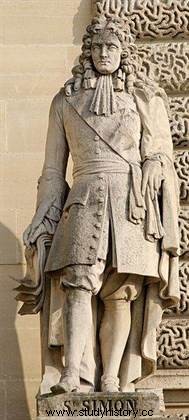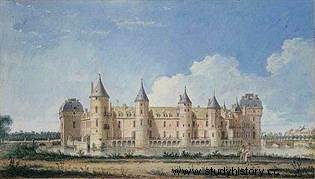 Louis de Rouvroy, better known as "Saint-Simon is a French memoirist whose Mémoires (1691-1723) constitute both historical and human testimony to the end of the reign of Louis XIV and to the Regency. It was already compared during his lifetime "to the most interesting and the most pleasant of dictionaries" by the Marshal of Belle-Isle, when the first edition of his Memoirs did not appear until 1829. In love with order and justice, in love with in all truth, passionate about the good of the State, his life as a courtier at Versailles, Fontainebleau, Marly, where intrigues and worldly events follow one another, gave him material for observation.
Louis de Rouvroy, better known as "Saint-Simon is a French memoirist whose Mémoires (1691-1723) constitute both historical and human testimony to the end of the reign of Louis XIV and to the Regency. It was already compared during his lifetime "to the most interesting and the most pleasant of dictionaries" by the Marshal of Belle-Isle, when the first edition of his Memoirs did not appear until 1829. In love with order and justice, in love with in all truth, passionate about the good of the State, his life as a courtier at Versailles, Fontainebleau, Marly, where intrigues and worldly events follow one another, gave him material for observation.
Louis de Rouvroy, Duke of Saint-Simon
Son of Claude de Rouvroy raised duke and peer by Louis XIII, Louis was born in Paris in January 1675. Baptized at Versailles in 1677, godson of Louis XIV and Marie Thérèse d' Austria, he is Vidame de Chartres and will take advantage of his great kinship with the Duchess of Angoulême, the future Princess of Ursins, Madame de Montespan, the Duke of Lauzun and many others.
 His father transmitted the essentials to him:honor, probity, the height of hearts but also pride and racial instinct. He also liked to remember the past and told his son many Court anecdotes. Perhaps, it is at this moment that Louis realizes that remembering is happy! Young Louis is virtuous, has no taste for women, gambling, or wine; instinctively, he recognizes honest people; he has religion and imagines a patriotic ideal mixed with his prejudices of rank.
His father transmitted the essentials to him:honor, probity, the height of hearts but also pride and racial instinct. He also liked to remember the past and told his son many Court anecdotes. Perhaps, it is at this moment that Louis realizes that remembering is happy! Young Louis is virtuous, has no taste for women, gambling, or wine; instinctively, he recognizes honest people; he has religion and imagines a patriotic ideal mixed with his prejudices of rank.
He entered the Musketeers at the age of seventeen, took part in the siege of Namur in 1692 and the battle of Neerwinden in 1693, then bought a cavalry regiment at the same end of year.
Became Duke of Saint Simon in 1693 and Peer of France, Governor of Blaye, Grand Bailiff of Senlis, Count of Rasse, Marquis of Ruffec, he married in 1695 one of the daughters of Marshal de Lorges, to which he remained faithful all his life. A gazetteer of the time made a pretty portrait of the bride “who is blonde and of the most beautiful size; that she has an extraordinarily fine complexion and a dazzling whiteness; the gentle eyes, quite large and well set, the rather long nose which raises his countenance, a graceful mouth, full cheeks, oval face, and a bosom which could neither be better cut nor more beautiful. All of this together forms an air of modesty and grandeur which inspires respect:she has, moreover, all the beauty of soul that a person of quality ought to have, and she will go hand in hand in merit with the Duc de Saint- Simon her husband, one of the wisest and most accomplished lords of the Court”.
His relationship with Louis XIV
 Admitted to the king, he is a diligent courtier and feels he is more destined for the life of the Court than to that of the army. However, in 1702, at the start of the War of Succession, failing to obtain a position while younger than him received promotions, he informed the king that he was leaving his service for "health reasons"! Louis XIV is displeased, and even if Saint Simon has sometimes the honor of being named for the candlestick at bedtime, he is stripped of any real advancement. The duke became even more assiduous, carried out his role of representation brilliantly, got involved in the demonstrations, began to record in his head a number of scenes, anecdotes and portraits "So I found myself instructed daily, in all things by pure, direct and certain channels, and of all things great and small. My curiosity, independently of other reasons, had a lot to do with it; and it must be confessed that, character or no one, it is only on this kind of food that one lives in the Courts, without which one only languishes there”.
Admitted to the king, he is a diligent courtier and feels he is more destined for the life of the Court than to that of the army. However, in 1702, at the start of the War of Succession, failing to obtain a position while younger than him received promotions, he informed the king that he was leaving his service for "health reasons"! Louis XIV is displeased, and even if Saint Simon has sometimes the honor of being named for the candlestick at bedtime, he is stripped of any real advancement. The duke became even more assiduous, carried out his role of representation brilliantly, got involved in the demonstrations, began to record in his head a number of scenes, anecdotes and portraits "So I found myself instructed daily, in all things by pure, direct and certain channels, and of all things great and small. My curiosity, independently of other reasons, had a lot to do with it; and it must be confessed that, character or no one, it is only on this kind of food that one lives in the Courts, without which one only languishes there”.
With his independent character and his freedom of speech, Saint Simon makes people envious, they want to harm him, they consider him dangerous and he complains to the king who replies " But also, sir, it's that you speak and you blame, that's what makes people speak against you, you have to hold your tongue.
Despite the king's aversion, the Duke and Duchess were often invited to Marly between 1710 and 1714, also having an apartment at the castle; the Duchess becomes lady-in-waiting to the young Duchess of Berry. Saint Simon feasts, he can "spy, see, listen at doors", also participating in several scandals such as "the affair of the Bonnets" and "the Unigenitus constitution", until 1715 when the king dies.
His friend Philippe d’Orléans
Philippe's childhood friend, Saint-Simon remains attached to him despite his nefarious side. He wants to bring out the "noble half" of the Regent, he strives to extract him from certain critical situations where he risks falling. Member of the Regency Council, often giving his opinion even if it is rarely taken into account, Saint Simon does not want to bother with the Seals and Finances, this is how Abbé Dubois takes an important place. to the government.
 Very straddling precedence, he has the satisfaction of seeing the bastards of Louis XIV reduced to their rank of peerage in 1718. He was also sent to Spain for the signing of the marriage contract between Louis XV and the little Infanta in 1721/1722. When the Regent died in 1723, he “died to the world” and retired from court. He comes from time to time to Paris, sometimes visits the Duchess of La Vallière or that of Mancini and "by the freedom of an old man and a great lord who has become a countryman, and to put himself more at ease, he put his wig on an armchair, and his head was smoking”.
Very straddling precedence, he has the satisfaction of seeing the bastards of Louis XIV reduced to their rank of peerage in 1718. He was also sent to Spain for the signing of the marriage contract between Louis XV and the little Infanta in 1721/1722. When the Regent died in 1723, he “died to the world” and retired from court. He comes from time to time to Paris, sometimes visits the Duchess of La Vallière or that of Mancini and "by the freedom of an old man and a great lord who has become a countryman, and to put himself more at ease, he put his wig on an armchair, and his head was smoking”.
The Memoirs of Saint-Simon
Having taken great pleasure in reading the Memoirs of Maréchal de Bassompierre, he took sixty years to produce his own, while at first seeking advice from the Abbé de Rancé, on how to proceed and the measures to be respected for such writings.
At the age of nineteen, when he was a captain in the Royal-Roussillon, he began to write, the day after the Battle of Neerwinden in July 1693 where he tells the facts in a firm and clear way, in a detailed bulletin for his mother and his friends.
Between his military campaigns and genealogical work on peerages and royal orders, he did not resume his Memoirs until 1739, after the Duc de Luynes gave him the "Fade Journal" of the Marquis de Dangeau, written between 1684 and 1720, a journal which will be very useful. In ten years, between 1739 and 1749, he wrote 2,800 large pages of tight lines as well as a "Parallel of the first three Bourbon kings" where he placed Louis XIII on a pedestal by declaring him greater king than his father Henri IV and than his son Louis XIV.
Unlike previous authors of Memoirs, he listens every day, he writes every evening; he knows everything and immediately keeps a record; it is only when he retires to his lands that he will coordinate this mass of information that he will put into shape.
 Previous authors limited themselves to overviews and outlines. Saint Simon, on the other hand, has a real observer's temperament, sometimes excessive; he will relate everything in detail:the events, the scenes of the Court, the marriages, the deaths, the faces, the expressions, report the conversations by even putting there the tone and the flow of the words. Everything is of interest to him. He says himself "These Memoirs are from source, from the first hand:their truth, their authenticity cannot be revoked in doubt, and I think I can say that there has not been anyone up to now who has understood more different subjects, more in-depth, more detailed, neither forming a more instructive nor more curious group”.
Previous authors limited themselves to overviews and outlines. Saint Simon, on the other hand, has a real observer's temperament, sometimes excessive; he will relate everything in detail:the events, the scenes of the Court, the marriages, the deaths, the faces, the expressions, report the conversations by even putting there the tone and the flow of the words. Everything is of interest to him. He says himself "These Memoirs are from source, from the first hand:their truth, their authenticity cannot be revoked in doubt, and I think I can say that there has not been anyone up to now who has understood more different subjects, more in-depth, more detailed, neither forming a more instructive nor more curious group”.
Of course there are some errors. We can forgive him. His Memoirs are not a History Book based on sources such as diplomatic letters, correspondence from ambassadors, military reports, original documents. His Memoirs are a moral story told by witnesses:we live at Court, we listen, we listen and we hear many things said; we watch, we spy; elders and servants are consulted; we are then only repeating what we have heard.
At the death of Saint Simon, fearing that his Memoirs would be used by ill-intentioned people, Choiseul, Minister of Louis XV, had all the Duke's papers transferred to the Depot in 1760 Archives; despite everything, there were a few publications of compiled and truncated extracts between 1788 and 1791. We had to wait for the first complete edition of his Memoirs in 1829 to obtain an unexpected result:a huge success, as if we were discovering the beautiful monarchical era , as if we were there, as if we were living there. His writings are kept at the National Library "under the safest locks".
The disappearance of the Duke of Saint-Simon
He died in March 1755. His mansion in the rue de Grenelle was demolished at the end of the 18th century, his Château de la Ferté sold to a financier; but fortunately it remains today its two Parisian hotels boulevard Saint Germain and rue du Cherche Midi.
Recognized as Great among the Greatest memoirists, André Gide noted "each sentence, each word lives, quivers, emancipates itself, bearing the mark of his impetuous spirit"; Emile Zola wrote “in our most illustrious authors, we can smell the rhetoric, the preparation of the sentence, a smell of ink emerges from the pages. With him, none of these things, the sentence is only a palpitation of life, the passion has dried the ink, the work is a human cry, the long monologue of a man who lives aloud”.
Bibliography
- Anthology of the Memoirs of Saint-Simon. The Pocket Book, 2007.
- Saint-Simon or The Court System, by Emmanuel Le Roy Ladurie. Fayard, 1998.
- Saint-Simon, by Denis Lorieux. Perrin, 2001.
